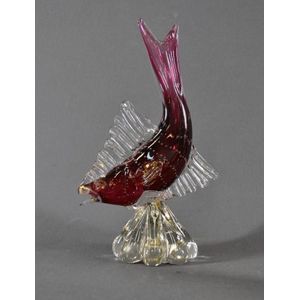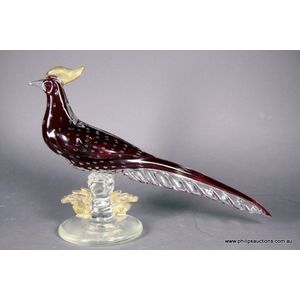1950s Murano Glass Pheasant Sculpture
A Murano glass pheasant, circa 1950s. The red glass pheasant on a perch, with a controlled bubble decor to the body, the comb, tail feathers and foliage with gold dust inclusions, raised upon a clear glass circular base; remnant foil label 'Made in Italy' underside. Height 27 cm. Width 40 cm
You must be a subscriber, and be logged in to view price and dealer details.
Subscribe Now to view actual auction price for this item
When you subscribe, you have the option of setting the currency in which to display prices to $Au, $US, $NZ or Stg.
This item has been sold, and the description, image and price are for reference purposes only.
- Inclusions - Inclusions in glass objects refer to small, often irregularly shaped particles or bubbles that are trapped within the glass during the manufacturing process. These inclusions can be intentional or unintentional, and can range in size, shape, and composition.
Intentional inclusions are often added to the glass for decorative purposes, and can include materials such as colored glass, metallic foils, or even small mementos like photographs or other objects. These intentional inclusions are typically added to the glass while it is still in a molten or semi-molten state and are then moulded or blown into the final shape of the object.
Unintentional inclusions, on the other hand, are typically the result of impurities or air bubbles that become trapped within the glass during the manufacturing process. These inclusions can be seen as small specks or bubbles within the glass, and can sometimes be a sign of poor quality control during production.
While intentional inclusions can be a desirable feature of some glass objects, unintentional inclusions can sometimes be seen as a defect, and can reduce the value of a piece. However, in some cases, certain types of unintentional inclusions can actually increase the value of a piece, such as with antique glass that contains bubbles or other imperfections that are characteristic of the time period in which it was made. - Decor Bois - "Decor bois" is a French term that translates to "wood decor" in English. It refers to decorative elements painted on porcelain items that simulate decorations in timber, such as carvings.
- Circa - A Latin term meaning 'about', often used in the antique trade to give an approximate date for the piece, usually considered to be five years on either side of the circa year. Thus, circa 1900 means the piece was made about 1900, probably between 1895 and 1905. The expression is sometimes abbreviated to c.1900.
This item has been included into following indexes:
Visually similar items

Murano glass table lamp. Dolphin form column. Height 40 cm (total)
Sold by
in
for
You can display prices in $Au, $US, $NZ or Stg.

Pair Daum crystal water bird figures. Signed. Height 43 and 36 cm
Sold by
in
for
You can display prices in $Au, $US, $NZ or Stg.

English hallmark sterling silver Art Nouveau hand mirror decorated with flowers and engraved 'Mrs J G Whyte' Sheffield, 1910, maker Walker & Hall length 26.5 cm
Sold by
in
for
You can display prices in $Au, $US, $NZ or Stg.

Murano glass fish. Red on clear base. Label attached. Height 25 cm
Sold by
in
for
You can display prices in $Au, $US, $NZ or Stg.
